ED. NOTE: These rules are reprinted with the kind permission of the author.
INTRODUCTION
These rules are intended to permit simple but fairly realistic wargames in which players with relatively few figures can refight colorful European actions of the mid-19th Century. The focus is on Napoleon III's Italian adventure and 1870 debacle. However, with a realistic assessment of the characteristics of different armies, the Crimean, Austro-Prussian and Mexican campaigns can be refought. With even more allowance for local eccentricities, the War Between The States and contemporary colonial battles can be accommodated. In fact, the rules dealing with fire effect and melee results do reflect consideration of American example. Since the emphasis is on European action, and the higher level organization of European armies of the period is not always known to the gamer new to the period, typical corps structures are shown at the end of these rules.
Early efforts to cope with this period realistically led to various problems, including the following:
1. Fine tuned fire resolution coordinated with extremely varied movement/fire rates gave some players headaches and led others to wander off while the umpire was working out the details.
2. Some of the most interesting actions looked into, such as Magenta, Solferino, Koeniggraetz, Vionville, and Gravelotte St. Privat were so large that tactical representation even at 1 to 100 became difficult.
The 1 to 100 or less level remains a goal. My own collection tends to be so organized that there are at least four corps per major army which can be represented as a single corps at lower level when suitable rules for a fast and satisfactory tactical game are developed. These rules permit lively action with approximately half hour game periods and two to three figures representing a battalion of infantry or artillery or a regiment of cavalry (some large Austrian and Russian regiments take two bases).
MOVEMENT SEQUENCE
Movement is simultaneous. Players will write down or declare orders at the beginning of each turn by agreement. In practice it may be more convenient to declare movement intentions until one or both players find themselves in need of written evidence that the enemy is not taking advantage of their declaration.
Units may be placed at their intended destination - however, the positioning is subject to modification due to unexpected sightings, morale tests, etc. When the opposing armies are arriving on the field by road or are otherwise not in close touch most moves may be placed without alteration. on the other hand, when two armies are moving at close quarters in broken ground it may be necessary to trace movements by fractions of the total move distances.
Since the move is intended to represent a longer time period than is usually the case, and a great deal may happen as movement Unfolds, changes in mid-course are allowed for under many circumstances. Thus, for example, a column of route on a road which sights a hostile force in battle order coming over a hill half a turn away may accept loss of distance for reaction, loss of distance for change of formation, and any adjustment to bring its trailing elements up, and proceed in battle order for anything remaining of its move. A change of direction where danger is not imminent, or clear opportunity does not present itself, especially if it reflects a change of direction from a higher level of command also requires deduction for the distance it would take a courier at charge speed to arrive from the commander who is changing the order.
One thing must be borne in mind -you cannot wait until an enemy unit has taken its full movement and then launch your troops at them for their full movement. If you keep a force hidden or undeclared until your enemy reaches striking distance and then move out, your residual movement is only equal to the proportion of the turn your opponent has not taken.
Turns or moves in a wargame are an administrative convenience. Troop units are not presumed to spend real periods at the halt at the end of each period of movement. If for any reason one player has moved a unit ahead of his opponent, for example, a cavalry force at tactical maneuver, and his opponent gleefully moves his own cavalry units into contact across relatively open country, the first player to move is not caught at the halt! Normally, depending upon the orders of the two units, they will make whatever adjustments are needed to face and/or alter formation, and charge one another. if one has orders to fall back if attacked, or if for some reason the player in charge of it lacks nerve (or possesses discretion) and it has the enemy in sight long enough to turn around and head back, it may do so.
When the movements come to close quarters action is normally resolved in the order that it occurs - generally artillery fire, small arms, and melee - in that order. However, it may occur that some units will reach melee earlier in sequence than others reach artillery fire. Morale checks are taken as needed before a unit passes from one type of action to another. For example, an infantry unit crossing artillery fire before reaching the range of its own weapons to open a firefight must check morale to see that it will press on after suffering long range losses. on the other hand, if it is attacking the artillery in question with the intention of closing with the bayonet, the artillery make take full effect on the composite rate "against a bayonet charge". By the same token, infantry with a shorter ranged weapon must check its long range loss morale results before closing for close range fire action. However, if an infantry unit is in range of an artillery unit at the beginning of a turn, their fire for their turn is presumed to be simultaneous (one or both is likely to be out of action at the end of such an exchange). The composite rate assumes that the attacker is under fire for the greater part of the time he would be in range. An attack from within musket range (rifled musket) would cut down on the kills subtract 2 from the firing die for rifles, which are fairly effective at long range, but only 1 from smoothbores --practically all of their effect against charges is close-in at canister range.
Once all firing, melee, and resulting morale effects are assessed, place the affected troops in the position dictated by their morale condition. Those beaten in melee during the first half of a turn, or forced back by morale results in the first half of the turn finish the turn as indicated and may be subject to fire or pursuit for half a turn. Otherwise retreats or routs take up all or part of the next turn. Once the move or turn is fully resolved, the sequence begins again.
Most corps level and larger games played by these rules have required opposing forces to maneuver into contact - one of the advantages of grand tactical representation. With 1.5" representing 200 yds., and each move representing 20 minutes action (and possibly 10 minutes inaction) game time will usually be far less than the period of time represented historically. There can be surprises - especially if hidden movement counters are used and scouting is sloppy - but in most games there are relatively few "Gotchas". A sound overall approach to the use of the strengths of your own army and a good overall battle plan are your best hope.
| MOVEMENT RATES BY ARM AND CLASS | ||||
|---|---|---|---|---|
| Cavalry | Road | Field | Tactical Maneuver | Charge Bonus |
| Light | 18" | 15" | 20" | 4" |
| Medium | 16" | 14" | 18" | 3" |
| Heavy | 15" | 12" | 16" | 3" |
| Infantry | Road | Field | Tactical Maneuver | Charge Bonus |
| Column | 12" | 8" | 10" | 2" |
| Line | - | 6" | - | 1" |
| Line Firing | - | 5" | - | - |
| Unsupported | Road | Field | Tactical Maneuver | Charge Bonus |
| Skirmishers | - | 5" | - | 1" |
| Under Musketry | - | 4" | - | 1" |
Artillery
Artillery has no charge move and may only use tactical maneuver to move to or from a firing position. Otherwise horse artillery moves as heavy cavalry and field artillery moves as an infantry column. Either type may prolong at the movement rate of unsupported skirmishers under fire.
MOVEMENT PENALTIES
Per contour of elevation crossed per turn:
Infantry -1/2"
Cavalry -1"
FORMATION CHANGES
Infantry & Cavalry -1"
Line Artillery unlimber & fire at long or medium range -2"
Line Artillery unlimber & fire at close range -1"
Horse Artillery as above an additional -1"
Any artillery limber and move -2"
| WEAPON RANGES 1850-71 | |||
|---|---|---|---|
| Weapon | RANGE | ||
| Short (4,5,6 hits) | Medium (5,6 hits) | Long (6 hits) | |
| Musket | .5" | 1.0" | 1.5" |
| Cap & Ball Rifle | 1.0" | 1.5" | 2.0" |
| Improved Cap & Ball Rifle | 1.0" | 2.0" | 3.0" |
| Smoothbore Carbine Mtd. | - | .5" | 1.0" |
| Smoothbore Carbine on Foot | .5" | 1.0" | - |
| Rifled Carbine Mtd. | - | 1.5" | 2.0" |
| Rifled Carbine on Foot | 1.5" | 2.0" | - |
| Early Minie or Tige Rifle, or Dreyse | 1.5" | 3.0" | 4.0" |
| Late Minie Type Rifle (Enfield '57, Springfield, Lorenz) | 1.5" | 3.0" | 5.0" |
| Chassepot Model 67 | 2.0" | 4.0" | 7.0" |
| Light Smoothbore Cannon | 3.0" | 6.0" | 9.0" |
| Medium Smoothbore Cannon | 4.0" | 9.0" | 12.0" |
| Light Rifled Cannon | 6.0" | 12.0" | 18.0" |
| Medium Rifled Cannon | 7.0" | 15.0" | 22.0" |
NOTE: The musket was used by French and Russian Line in the Crimea, Sardinian Line in the Crimea, and the 2nd British Infantry Division. The cap and ball rifle was used by Russian Jager, the improved cap and ball rifle by the Sardinian Bersaglieri. French Chasseurs a Pied, Guards, and most British line and all rifle units used the early Minie. It was also used by Prussian line jager until the early 1860's. At that time musketeer battalions had muskets, but the fusilier battalions and guards already had the Dreyse. The Minie was adopted by the French line before 1859 and a large number sold to Sardinia (Piedmont). it was not replaced by the Ch as, ot until 1867. The Lorenz came into service in Austria prior to the 1859 campaign and was likewise replaced by a breechloading version then by the Werdl breechloader beginning in 1867 after the Seven Weeks Field Trials of breechloaders versus muzzle loaders in 1866.
When applying the simplified tables against infantry charges screened by skirmishers, or when using smoothbore muskets against charges, subtract 2 from the firing unit's die score.
FIRE ACTION USING THE SHORT TERM OR "SINGLE SHOT" METHOD
Maximum "shots", or single die rolls allowed per base in one turn is 8 for artillery, 6 for infantry. A stand up fire fight at constant range between two infantry forces would theoretically involve 4 die rolls, but will instead be resolved using the simplified tables. Smoothbore artillery at short range, or breechloading shoulder arms use 2 dice instead of 1.
The number of shots (dice thrown) is modified by the proportion of the turn in which firing takes place. To achieve the maximum number of shots the firing unit must be in place ready to fire at the beginning of the turn and the target in range the entire turn. The number of dice used or the percentage of the simplified fire table effect used depends on the percent of the move engaged in firing. A change of artillery targets takes as much time as 1" of movement for foot artillery or 2" for horse artillery.
SIMPLIFIED FIRE TABLES FOR SOME COMMON SITUATIONS
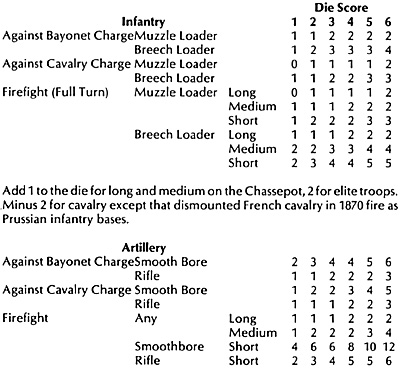 The tables at right are intended to simplify the large number of dice rolls per battalion required by this game. By using the tables below it will only be necessary to roll one die per firing base per turn. Round fractions up:
The tables at right are intended to simplify the large number of dice rolls per battalion required by this game. By using the tables below it will only be necessary to roll one die per firing base per turn. Round fractions up:
Add 1 to the die if gunners are not under fire. Add 2 to the die if Prussian in 1870-71. Subtract 2 from the die if under infantry or short range fire Add 2 to the die if target is in close order except for smoothbore at short range (canister).
The above tables are strongly recommended when they apply to as much as even 1/4 of a turn. For example, if a target is under fire of rifled muskets for 1/4 turn at medium range the choice is between 1 roll at 5-6, or one roll at the composite rate, with a 5-6 to confirm the in the first case for a second roll, followed by a roll for5-6, orjusta confirmation roll of6or5-6 in the second case. When half a turn is involved, the advantage is clear if a charge which requires half a turn or less to close is stopped with a morale result which permits the attacker to halt and fire, edch side may exchange half a turn of fire at the indicated range during the latter half of the turn.
SUMMARY OF FIRE MODIFIERS ON CASUALTIES
(Reductions are cumulative.)
- Target in open order - divide by ratio of extended to normal frontage.
- Target in wood edge - divide by 3.
- Target prone - divide by 3.
- Screened by shirmishers - divide by 2 but doesn't count at close range for infantry. 1/4 of total casualties against the skirmishers. Does not count for long and medium range smoothbores.
- Solid building - divide by 2 for artillery, divide by 3 for infantry (any buildings are solid for infantry fire).
- Earthwork - divide by 3 for artillery or infantry. No infantry casualties if defenders are not firing. Special rules needed for permanent works.
- Long and medium artillery against moving cavalry at tactical maneuver rates - divide by 2.
CASUALTIES
Each base, representing a battalion of infantry or artillery and approximately 4 squadrons of cavalry (1-2 bases per regiment) has a roster value of 5. When 5 casualties have been suffered, the unit is considered out of action. This should not be construed to mean that the unit has suffered 100% loss in killed and wounded. Historical evidence, as well as professional military staff games have reckoned units out of action at various points from 30% to 60% killed and wounded. The 5 casualty point in this game should be regarded as approximately 50%. In a campaign it may be desirable to worry about the fate of the last 50% of the unit, but tactically it is unnecessary.
A convenient way to keep track of casualties is to cut out a number of small cardboard squares, most with a '1' on one side, a "2" on the other, the rest with "3" and "4" on opposite sides. On receiving the first hit a unit has a hit with '1' placed on it. With another hit, the marker isturned over to show a "2". This procedure is followed until the fifth hit, at which point the unit is removed entirely.
For diorama effect, casualty figures may be placed at the point where the unit broke down; a dead or wounded man for infantry or guns, a horse for cavalry.
MORALE
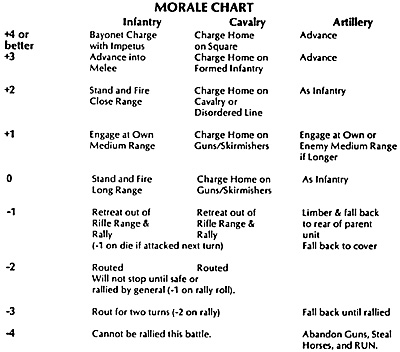 Morale is automatically affected as a result of melee. it must also be checked when a unit comes under fire and receives casualties. The morale check is normally accomplished by rolling one die per base, averaging the dice for a higher level unit, and adjusting the result by the unit's number of losses and other modifiers.
Morale is automatically affected as a result of melee. it must also be checked when a unit comes under fire and receives casualties. The morale check is normally accomplished by rolling one die per base, averaging the dice for a higher level unit, and adjusting the result by the unit's number of losses and other modifiers.
Initial or starting morale (before rolling the dice) in any given turn must net out at "0" or below. That is, all positive modifiers (deep order, guard or elite status, general present, etc.) will not serve to give the unit a morale higher than a completely unharmed unit. This focuses morale effect on current casualty rate. Thus a guard unit with three casualtiesat the start of a turn, formed in column, led by a general, starts at "0", while a line unit in the same condition, in line, without a general, starts at -3.
When a move has been completed and fire casualties assessed, the attacker rolls for the morale of affected units. If the attacker fired, or supporting units have inflicted fire casualties on the defender, the defender also rollsfor morale. In fact, if the defender's casualties arefrom artillery fire prior to the attacking infantry coming into rifle range, the defender must check morale first - his morale may not permit him to remain when the attacker reaches close range.
Once the morale has been determined, unitswill be placed accordingto the results. If the morale roll permits new firing, that will take place and any resulting morale will bechecked. Forexample,an attacking unit goes in with orders to rely on the bayonet. It receivestwo casualties and rolls a 4. Charging home with the bayonet requires more than the result of +2. However, +2 permits the attacker to halt and fire at close range, so the attacker will be placed at 1" from the defender and roll at 4-5-6. if a hit is scored, and the defender rolls a 1, he must retreat to long range (3") or a 2, he must retreat to medium range (2").
Infantry seeking to resume its advance after being halted by fire or receiving a cavalry attack on the previous turn must be ralled to advance with a roll of 5-6 on an ordinary die. Normal modifiers apply. If the enemy has retired out of rifle range (or, cavalry has been repulsed) add one to the score. If the enemy is still retiring, roll only to see when in the turn the unit will advance; 1-2, lose 1" of movement, 3-4, lose 2" of movement.
MODIFIERS TO MORALE
Modifiers to a charging unit on a given move may net no higher than "0" at start (before dice throw).
- +1 General with unit. Guard or Grenadier. Defending hedges, fences.
Enemy flank exposed at start of charge. Infantry in deep order.
+2 Defending buildings, trenches. Infantry in square threatened with shock attack. Guard or Grenadier called on to advance in fire fight at start of turn. Cavalry to charge once rallied.
-1 Reactive formation. Facing change within 1/2 turn of morale check. Friendly unit forced to retreat. Light troops defending obstacle against charge. Crossed disordering terrain this turn without rally. For each casualty. Charging if self screened by skirmishers. Charging defenders with smoothbore muskets.
-2 Line troops in skirmish order. Threatened with flank charge this turn. Fired on in road column (0 or less will force halt or deployment). Troops ordered into fire from buildings or from prone position.
Example: General with unit, +1; guard unit, +1; enemy retiring out of range, +1; unit prone, -2; net +1, so a roll of 4-5-6 will move the unit.
Modifiers are cumulative. Any carry over from prior turn is also added if necessary (i.e., if shown on prior chart).
Two or more battalions of a regiment acting as a unit may average morale results, thus the modified factor from three die rolls are averaged and the result applied to the entire regiment. However, when this is done with units side by side in a single line with no supporting line, subtract 1 from the averaged result.
When infantry reacts to face a threatened charge developing during the turn it loses the long range shot against cavalry. if the attacker is inside rifle range before the movement is complete, the close range hit is not automatic.
A unit rolling to resume advance after a fire action, etc., does not deduct casualties as long as the advance does not take it beyond its prior morale condition. That is, if a unit halted at medium range, but allowed by morale roll to go to close range attempts to advance, a 5 or 6 (with previously listed modifiers) will suffice. If it is already at close range, and wishes to stop firing and charge home, it must subtract 1 or 1/2 its casualties, whichever is greater.
If a unit is required by its morale roll to go to a longer range than it finds itself from the enemy, it must retreat. if the enemy is advancing it will continueto retreat, and if unableto maintain its distance at a retreat firing speed, it will cease fire. if the enemy continues to gain at the maximum speed permitted by the unit's formation, it will break into rout. When infantry is in an adverse morale condition and faced with a cavalry charge, it will be overtaken and fight at half value, counting as disordered.
For example: if the infantry takes hits during the turn that it is being charged and receives a morale roll permitting it to stand and fire at medium range, instead of using the fire against cavalry charge table, it fires a shot at medium range and counts as disorganized in the melee if the cavalry morale check permits the attacker to "charge home on... disordered line."
| MELEE VALUE | ||
|---|---|---|
| Unit | Basic (per base) | Impetus |
| Guard Cavalry | +.5 by type | 2 |
| Cuirassiers | 2.0 | 2 |
| Medium Cavalry | 1.5 | 2 |
| Light Cavalry | 1.0 | 2 |
| Guard infantry | 3 | 1 |
| Grenadier | 2.5 | 1 |
| Line or Light | 2 | 1 |
MELEE VALUE MODIFIERS
- Square double (x2) against cavalry.
+2 Against flank. Against rear. Defending fences, walls.
+3 Defending earthworks.
+4 Defending buildings (4 arty hits reduce building value to a wall)
-1 (per base)if disordered
Infantry battalions from the same regiment may melee up to two deep. Cavalry only one base deep. Walls, buildings, and earthworks cannot be charged by cavalry.
Each side rolls 3 dice for each unit engaged. Highest modified total is winner of melee. Two dice are then rolled for result. A "0" difference results in a retreat in order for at least half a move. Differences more than 1 are as on the morale reaction test except that guns are spiked on a difference of 0-1, captured on 2-4. Standards are captured on a difference of 5. Differences of 0-2, 1 casualty per victorious unit; 3-5, two casualties. Victor loses 1 if loser is not broken.
Cavalry may persue units retreating more than 1/2a moveand automatically win another melee. Casualties are one on a difference of 0-2; 2 on a difference of 3-5.
FORMATIONS
A typical unit of this period would fight in a three rank line, two ranks for British troops and some formed light troops. Occasionally the line would be four deep. The scale width of a three rank line is represented by a battalion base 1.5" wide.
Regiment (3 Btns) in Line
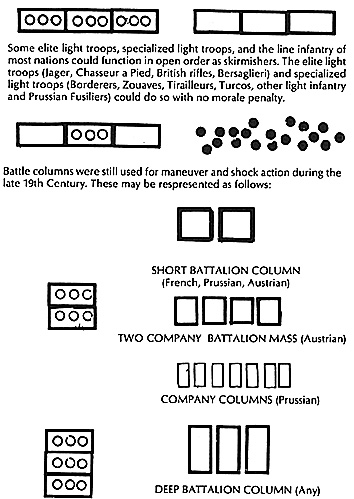
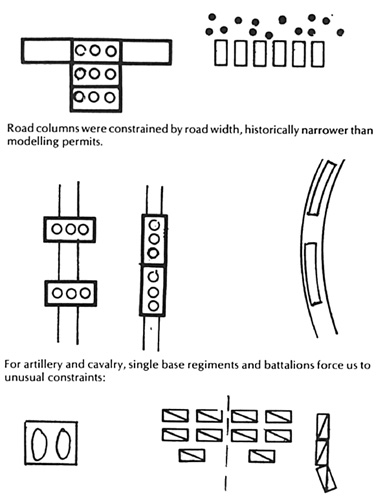
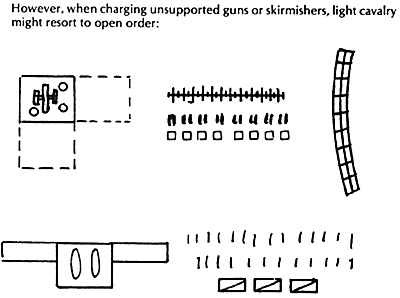
REDUCED ARTILLERY FORMATIONS
The normal artillery model represented in this game is held to be approximately 24 pieces, or 3-4 batteries. This level is representative of less manpower than an infantry base, but, since artillery did not fight shoulder-to-shoulder we may assume that each hit represents an equal proporationate but smaller absolute loss of manpower. Since the normal artillery tactical unit was the battery, this is a less than ideal solution, but the battery, equivalent to a weak infantry company, is too small a force for our reckoning. However, in some cases it may be desirable to present units of 12 to 18 guns on the field. This can be done by counting 3/4 of the full unit value, or 1/2, as appropriate. Units of 18 to 24 guns must be represented as occupying two base depth when on the march and two base width deployed. This can be done by placing a team and limber beside a deployed, or behind a moving artillery "battalion". A unit of 12 guns would not occupy more than normal base frontage or depth. The smaller units with 12 to 18 guns would be removed with the 3rd or 4th hit rather than the 5th.
THE MONTIGNY MITRAILLEUSE
No Franco-Prussian wargame is complete without the Mitrailleuse. It played a spectacular if largely unsuccessful role in the brief campaign that ended the Second French Empire and began the Second German Empire. A Belgian invention, this weapon was sometimes termed a "canon a balles", or "bullet cannon". It fired bullets from multiple barrels in what was intended to be a flat canister-like spread - 36 barrels in the early models using a special bullet, 25 firing a standard Chassepot round in the production model.
After some years of development effort and general lack of interest, the mitrailleuse was plucked from obscurity after the 1866 War. The deadly Dreyse suddenly shook French faith in the Minie rifle and bayonet. Unfortunately the antidote was treated in practice as an artillery weapon and equipped a number of French batteries in 1870. The result was an artillery force on the French side with what amounted to a long canister range but no provision to fire shot or shell.
In this game an artillery piece normally represents 3-4 batteries, or 24 guns. The mitrailleuse is a problem, for while used in a battery, it was not normally used in massed batteries. it is recommended that 1-2 double batteries, that is, pieces representing 12 guns, be used per French Corps. They will have the fire power of a full chasseur a pied (elite chassepot) battalion but be putoutof action on thethird ratherthanfifth casualty. If an isolated division's artillery is being represented, the "double battery" may be treated as a full battery against unprotected targets within Chassepot range, and be put out of action on the fourth casualty. Against a cavalry charge, such a battery would be treated as a smoothbore battery.
Corp and Division Organizations (very slow: 276K)
Back to Table of Contents -- Courier Vol. VII #5
To Courier List of Issues
To MagWeb Master Magazine List
© Copyright 1987 by The Courier Publishing Company.
This article appears in MagWeb (Magazine Web) on the Internet World Wide Web.
Other military history articles and gaming articles are available at http://www.magweb.com